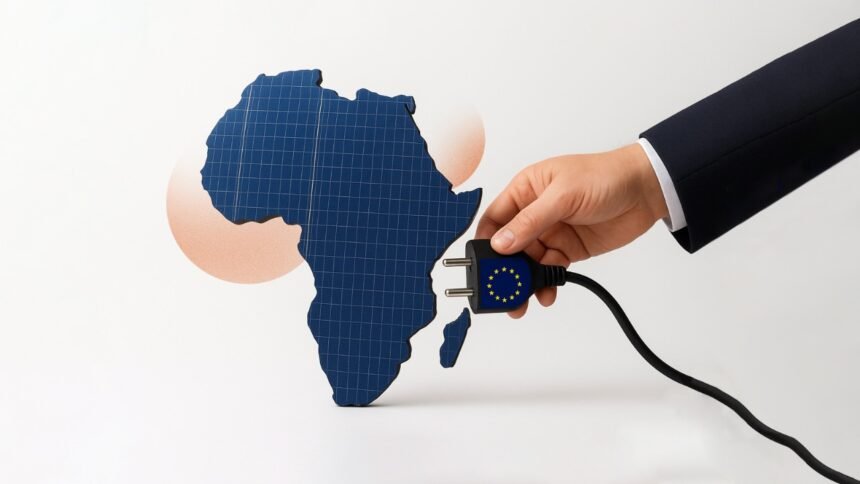If money talks, then Europe just raised its voice. With a staggering $600 billion commitment to clean-energy projects across Africa, Brussels has unveiled what may be its most ambitious development gambit in decades and one that speaks as much to politics as to power grids. The initiative, part of the EU’s Global Gateway strategy, aims to fund renewable-energy infrastructure, boost electrification rates, and, not coincidentally, counter China’s growing influence on the continent.
The announcement, made this week in Brussels and warmly echoed in Nairobi, Lagos, and Addis Ababa, was wrapped in the language of partnership and sustainability. European Commission President Ursula von der Leyen hailed it as “an investment in Africa’s future and Europe’s shared prosperity.” Translation: Europe wants to keep Africa’s lights on — and its loyalties close.
Africa, home to 60 percent of the world’s best solar resources but only 3 percent of global energy investment, has long been described as the sleeping giant of the green transition. From the Sahara’s endless sunlight to the Congo’s roaring hydro potential, the continent could power itself many times over — and export clean energy to boot. Yet for all the promise, nearly half of sub-Saharan Africa’s population still lives without reliable electricity. In some regions, power cuts are as routine as sunrise.
Enter Europe, eager to change that narrative — and, let’s be honest, its image. The Global Gateway initiative is Brussels’ answer to China’s Belt and Road. It promises transparency, sustainability, and democratic values over opaque deals and debt traps. But the numbers are breathtaking: $600 billion in combined public and private investments, with more than 30 African countries expected to benefit. Projects range from Morocco’s massive solar farms and Kenya’s geothermal plants to new grid interconnectors in West Africa and green hydrogen hubs in Namibia.
European officials insist this is not charity — it’s smart economics. Africa’s population is booming, expected to double by 2050, and its energy demand will follow suit. By helping Africa leapfrog into renewable generation, Europe not only supports sustainable growth but also secures new markets for its own green technologies. “This is about mutual gain,” said Jutta Urpilainen, EU Commissioner for International Partnerships. “We’re not giving handouts. We’re building a partnership for the future.”
Still, the timing and tone carry unmistakable strategic undertones. As China deepens its economic presence through infrastructure loans and Russia courts African leaders with energy and security deals, Europe is anxious to reassert itself as a reliable, values-based partner. The clean-energy drive offers a narrative of empowerment rather than exploitation — and a badly needed diplomatic reboot.
But critics are wary. African energy analysts note that Western funding pledges often arrive with fine print — environmental conditions, governance benchmarks, and procurement rules that can slow implementation or favour European contractors. “We welcome investment,” said Nigerian energy economist Aisha Yusuf, “but not paternalism dressed in green.” Others question whether the full $600 billion will truly materialise, pointing to Europe’s past record of generous announcements and modest disbursements.
The stakes, however, are immense. According to the International Energy Agency, Africa needs at least $190 billion a year in energy investment to achieve universal access and net-zero targets by 2050. Even if Europe’s pledge covers only a fraction of that, it could be a catalytic start — especially if paired with African leadership in planning and implementation. Some of the most exciting developments are already home-grown: Kenya’s near-total reliance on renewables, Rwanda’s solar mini-grids, and South Africa’s ambitious Just Energy Transition plan.
Indeed, the EU’s challenge may not be writing the cheque, but sharing the control. African leaders are increasingly assertive in shaping their own energy agendas. They want to ensure that solar panels, batteries, and wind turbines are manufactured locally — not imported wholesale. “We don’t want to be the world’s testing ground for technology,” said Ghana’s Energy Minister Matthew Opoku Prempeh recently. “We want to be part of the value chain.”
There’s also the thorny question of Europe’s motivations. Some observers see the pledge as a geopolitical double play: reducing Africa’s carbon footprint while securing alternative energy partnerships that could offset Europe’s dependence on fossil imports after the Ukraine war. In that light, the Global Gateway looks less like a gift and more like a carefully calibrated investment in future supply lines.
Still, cynicism aside, if even half of the pledge translates into functioning grids, renewable capacity, and local jobs, it would be transformative. Millions could gain access to electricity for the first time; industries could shift from diesel generators to solar micro-grids; rural schools and clinics could finally keep the lights on.
In the end, Europe’s $600 billion gambit may be remembered not for the money itself, but for what it symbolises a recognition that Africa’s energy future is central to the planet’s climate equation. Whether this becomes a true partnership or just another round of donor diplomacy will depend on execution, accountability, and, above all, trust.
For now, though, the message crackles loud and clear: Europe wants to plug into Africa’s future before someone else does.










